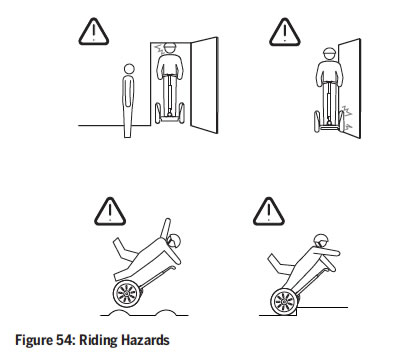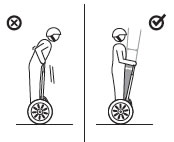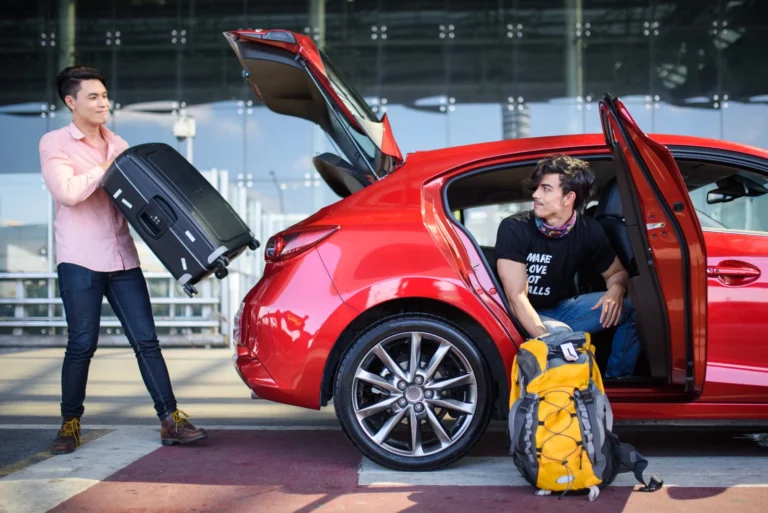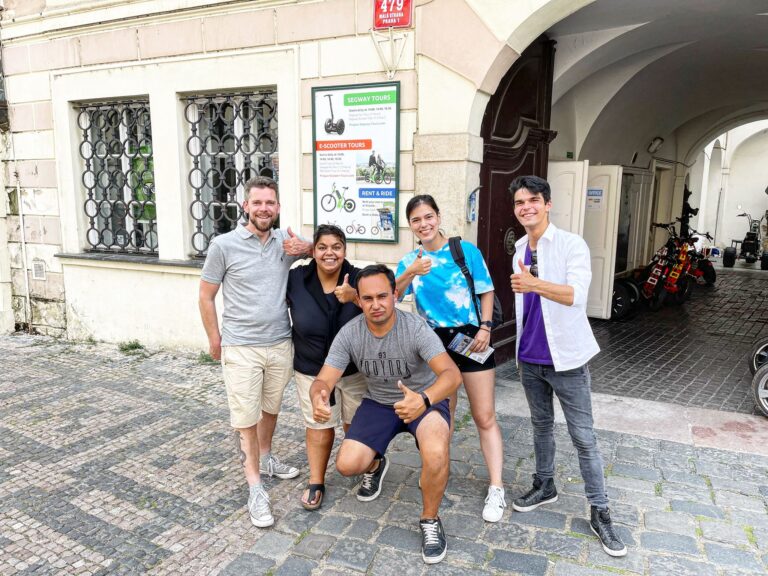Practice Riding
You will need to become very familiar with your Segway PT before you attempt to ride outside of your controlled practice environment. The more you practice, the safer you will be when you move into new places. Remember the following as you practice:
- Use the Beginner Setting and ride in areas free of obstacles and distractions until you are comfortable on your PT. Practice at the Beginner level until you can step on, ride forward and backward, turn, stop, and step off with the same precision and confidence as you walk.
- With practice, you should be able to ride in narrow areas. You should also be able to ride, turn, and stop on a narrow, curving, paved walkway.
- Until you can ride with this precision, do not attempt to ride in any area where you might encounter children, pedestrians, pets, vehicles, bicycles, or other obstacles and potential hazards.
- Your first rides without the Beginner Setting should be in the same secure areas where you learned to ride with the Beginner Setting.
- Use caution when riding in new environments.
- Be careful when riding through a doorway.
- Make sure you leave enough Wheel clearance.
- Watch out for terrain transitions such as pavement and grass.

Navigating Terrain
With practice, you can learn to ride over many different types of terrain, provided you avoid slippery surfaces, loose materials, steep slopes, and obstacles.
Always proceed slowly over unfamiliar terrain. Never allow the PT to become airborne, even for short periods of time, because the PT has no traction when airborne, and you could lose control upon landing.
Terrain Compensation
The PT is designed to compensate for uneven terrain. When riding straight on uneven terrain, keep the LeanSteer Frame vertical. Point the LeanSteer Frame in the direction you want to move and allow the Powerbase to follow the contour of the ground.

Navigating Stairs and Curbs
WARNING
If the Wheels slip while guiding the Segway PT up or down stairs or curbs, the PT may exit Riderless Balance Mode and enter Standby Mode. The PT will not “assist” you in moving up or down the stairs while in Standby Mode. Slowly and carefully guide your PT down the stairs. Re-enter Riderless Balance Mode before you try again.
WARNING
Keep the Segway PT below you at all times. Lead it up the stairs, curbs, and slopes and keep it below you when descending stairs, curbs, and slopes.

- Step off of the Mats.
- Check the Console and verify the PT is in Riderless Balance Mode (see Table 3, p. 31).
- Walk around so you are in front of the PT.
- Carefully guide the PT to the stairs and align the Wheels perpendicular to the stairs or curb.
- Always stand above the PT, facing the Handlebar. Gently guide the PT up or down, one step at a time.
Riding Etiquette
User proper etiquette when riding your PT.
- Be careful and considerate of others.
- Always ride under control at a speed that is safe for you and those around you.
- Always be prepared to stop.
- Respect pedestrians by always yielding the right of way.
- Avoid startling pedestrians. When approaching from behind, announce yourself and slow down to walking speed when passing. Pass on the left whenever possible. When approaching a pedestrian from the front, stay to the right and slow down.
- In heavy pedestrian traffic, slow down and proceed at the pace of pedestrian traffic. Pass only if there is ample space to do so safely. Do not weave in and out of pedestrian traffic.
- When riding with other PT riders, maintain a safe distance, identify hazards and obstacles, and do not ride side-by-side unless there is plenty of room left for pedestrians.
- Do not park your PT in a way that blocks pedestrian traffic.
- Cross roads at designated crosswalks or signaled intersections. Do not jaywalk/ride.
- Only travel on a road when a pedestrian way is not available or when sidewalk use is not allowed. Do not ride your PT on private property (inside or outside) unless you have obtained permission to do so.
- Learn about and obey applicable laws and regulations.
Riding Tips and Safety Guidelines Recap
The Segway PT’s unique balancing ability and ease of use may lead you to become overconfident. If you exceed the ability of the PT to balance, such as by riding over obstacles, uneven terrain, slippery surfaces, loose materials, or steep slopes, you can very quickly lose control, leading to collisions, falls, and injury. As with any other transportation device, using a PT exposes you to risk of injury. You can reduce the risk by following all the instructions and warnings in this Manual, but you cannot eliminate the risk.
- Read this Manual and watch the Safety Video.
- Pre-ride inspection. Inspect your PT before each use (see “Pre-Ride Checklist” on the inside back cover of this manual). Do not use if any part is loose or damaged. If you discover any loose or damaged part, see “Troubleshooting Procedures” (p. 119).
- Do not place any objects on the Mats. This could cause the PT to move on its own when in Balance Mode, possibly damaging your PT and rendering it unsafe for use.
- Do not allow any person to use your PT unless that person has carefully read this Manual and watched the Safety Video.
- Do not use the PT in hazardous atmospheres. The PT has not been certified for use in hazardous atmospheres as defined in NFPA 70, National Electric Code. Hazardous atmospheres are locations where fire or explosion hazards may exist due to flammable gases, vapors, liquids, dust, or fibers.
- Wear a helmet. Whenever you ride your PT wear a helmet that fits properly with the chin strap in place. Use an approved bicycle or skateboard helmet that provides protection for the back of your head. Depending on riding conditions and your riding experience, consider using additional protective equipment such as gloves, eye protection, wrist guards, and knee pads. Wear footwear that protects your feet and provides adequate support and comfort.
- Spot new riders until they are comfortable with the basic operation of the PT. All new riders should use the Beginner Setting. The safety of new riders is your responsibility. Do not allow anyone to step onto the PT for the first time unless you are there to hold the Handlebar. Do not let new riders operate the PT outside of your direct supervision unless they have read this Manual and watched the Safety Video.

- Avoid slippery surfaces, loose materials, steep slopes, and obstacles. If you cannot avoid a slippery surface, loose material, steep slope, or obstacle, then you must step off and use Riderless Balance Mode to move across it. Be especially careful when riding in confined spaces or near obstructions.
- Use caution on slopes. Use caution when ascending, descending, or crossing slopes. Do not attempt to ride across any slopes with loose material or slippery surfaces. Instead, step off and use Riderless Balance Mode, walking with the PT held downhill from you. When riding across any slope, lean uphill to maintain balance.
- Watch those turns! Always turn slowly and with caution. Fast turns can lead to loss of control and falls. Lean into turns.
- Do not take risks. When you encounter a slope, uneven terrain, or other terrain feature with which you are not experienced or that makes you at all concerned about your safety, do not risk riding over it. Instead, step off and use Riderless Balance Mode.
- You are taller than you think. Be aware of the added height that the PT (and your helmet) gives you and use caution when riding indoors or in the vicinity of doorways, archways, branches, signs, or other low overhead obstacles.
- Do not wear loose clothing that can catch in the Tires and prevent proper steering.
- No passengers. The PT is for one rider. Do not ride double or carry any passengers. Do not carry a child in your arms or in a child carrier while riding. Expectant mothers should not ride the PT.
- Do not exceed the maximum weight limit (rider and all cargo) specified in this Manual. If you exceed the maximum weight limit, you are at greater risk of falling and injury, and damage to the PT could result. Also, the rider’s weight must not be less than the minimum rider weight limit specified in this Manual. If you are below the minimum rider weight limit, you may not be able to ride safely because you cannot shift your weight far enough back (behind the center line of the Wheels) to safely slow down and stop, especially when riding downhill. Riders below the minimum weight limit might also fail to properly activate the PT’s Rider Detect Sensors. For additional information on weight limits, see “Operating Limits” (p. 14).
- Never ride on stairs or through revolving doors. Riding on stairs is extremely dangerous, as is riding on escalators and through revolving doors.
- Do not step off a moving PT. Always come to a stop before stepping off.
- Do not ride in the dark. Do not ride the PT in low visibility conditions without a light. To ride safely, you must be able to clearly see what is in front of you and you must be clearly visible to others.
- Be alert. As with any other transportation device, you must be mentally alert to safely ride a PT. Do not attempt to ride if you are ill or if you cannot comply fully with the instructions and warnings in this Manual. Do not ride under the influence of alcohol or drugs. Avoid distractions. Do not use a mobile phone, listen to headphones, or engage in any other activity that might distract you or interfere with your ability to monitor your surroundings while riding.
- Be prepared to stop. Be especially careful when approaching or crossing intersections, driveways, corners, doorways, and other areas where you may need to slow down or stop to avoid motor vehicles, bicyclists, or pedestrians.
- When riding, keep both hands on the Handlebar and both feet on the Mats. Be relaxed. Ride in a relaxed position with your knees and elbows slightly bent and head up. Do not attempt to carry any object in your hand(s). If you need to carry any object, use a cargo accessory that is recommended by Segway or a securely attached backpack with both shoulder straps in place.
- Never restart and ride your PT after it has indicated an empty Battery condition or performed a low Battery Safety Shutdown. The PT may not have enough power to keep you balanced, especially if you demand a lot of power at once. If you restart and continue riding, you risk falling. Also, you may damage your Batteries, resulting in reduced Battery life and capacity.
- Do not ride backward, except to maneuver a few feet. Instead, turn and ride forward. There is a difference between maneuvering backward and riding backward, similar to the difference between stepping back and walking backward. Maneuver backward only when necessary to open a door or back away from an obstacle. Avoid turning while maneuvering backward.

- Riding on the road. The PT is not intended or recommended for primary use on roads. If you must ride on the road, or must cross the road, be extremely careful. Ride as far away from traffic as possible. Allow plenty of time for crossing roads. Remember, the Speed Limiter or an unexpected obstacle could slow your crossing. Check to make sure that riding on the road is allowed by law.
- Never let go of a balancing PT. Never let go of your PT when in Balance Mode, because the PT will travel some distance on its own before transitioning to Standby Mode. The PT will not travel very far if you let go of it when it is stopped. But, if you let go of it when it is moving at any speed, it could travel much farther, risking injury to others and damage to the PT.
- Carrying cargo. To carry cargo, use a cargo accessory that is recommended by Segway or a securely attached backpack with both shoulder straps in place. Do not place cargo (or any object) on the Powerbase. The total weight of any Handlebar payload plus any other attachments hanging from the Handlebar should not exceed 10 lbs. (4.5 kg). Exceeding this limit interferes with the PT’s balancing ability and could cause the PT to accelerate on its own, risking injury and damage.
- Leave a gap! Leave a gap between yourself and the Handlebar. Do not lean over or into the Handlebar. Leaning over or into the Handlebar dramatically increases the risk of loss of control, collisions, and falls.
- Do not ride the PT if you suffer any impairment to balance.
- The PT has not been designed, tested, or approved as a medical device. You must be able to step on and off the PT unassisted, which requires physical abilities similar to ascending and descending stairs without assistance and without holding the handrail.
- Segway recommends that you not allow children to ride your PT unless: (a) you have first learned to ride, so that you understand the care and skill required to ride safely; (b) the child has read this entire Manual and watched the entire Safety Video; and (c) you are satisfied that the child has the knowledge, maturity, and physical ability to ride safely without endangering him/herself or others. As a general rule, Segway recommends that riders be at least 16 years of age. Keep in mind, all Segway PT riders must weigh at least 100 lbs in order to activate the rider detect system.




